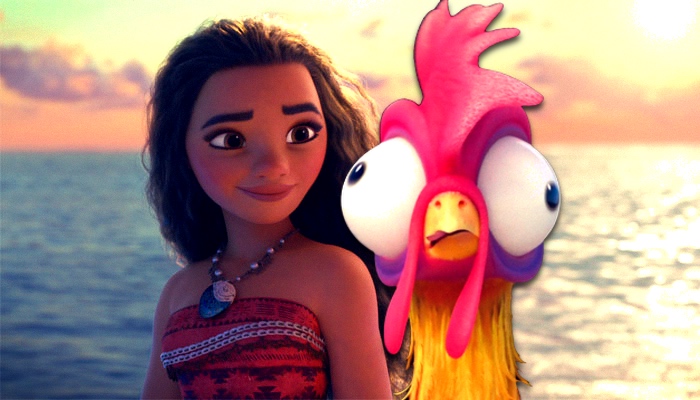
The Meaning Of Heihei: Here’s What Moana’s Chicken Is Really All About
Moana is a 2016 Disney animated movie about a young woman who joins a charismatic demigod to restore the heart of a goddess and break a centuries-long curse. It also stars a chicken. But this ain’t no ordinary dumb cluck.
In the long tradition of Disney animated films, after the whole princess thing, if there is one unbreakable trait that runs through all of these movies, be them classics or not, it is the colorful sidekick that joins the protagonist on their many adventures. Every hero has one. Heck, even the bad guys occasionally get one (we’re looking at you, Iago). These little creatures have become so popular, they sometimes get their own movies and near a cult-like following. A few of the most well-known companions are Timon and Pumba from The Lion King, Flounder from The Little Mermaid, and well, just about all the furniture and housewares from Beauty and the Beast. One thing is for certain, they aren’t going anywhere.
This year’s Moana, a story about an independent girl who, about to become the chieftain of her people in the South Pacific, sets out on an ocean voyage quest to find a once powerful demigod and convince him to undo a terrible curse begun after he stole the green-stone heart of the goddess Te Fiti. What Moana doesn’t know though–until she’s already well away from her island home, is that stowed aboard her camakau (a kind of traditional sailing boat), is her pet chicken Heihei, a bantam rooster that well, isn’t so well endowed with anything resembling intellect.

Truthfully, the chicken is dumb. Like, really dumb. A creature seemingly so devoid of rational or constructive thought, it doesn’t even have the wherewithal to know the difference between seed and a polished stone more than double the size of its head. It eats both. Throughout the film, the bird is seen in increasingly absurd situations that demonstrate an animal of monumentally inept ability and lacking in basic cognitive reasoning. This is one stupid chicken. Or so we are meant to think.
Before I delve into why, let’s reflect on a few of the more popular sidekicks and their typical role, starting with the aforementioned Timon and Pumbaa. Here are two animals, a meerkat and a warthog, that not only have the power of speech, but are highly-social, critical-thinking, and independent-minded. In fact, there are any number of sidekicks that nearly meet the same level of intelligence. Sure, not all speak, but they do communicate and extend themselves into the story in many worthwhile ways. These animals and creatures serve a hugely significant role in their respective films, often becoming integral to a story’s outcome.

Yes, Heihei (voiced by Alan Tudyk) has his part to play in the story, but why would Disney create what is easily the least intelligent sidekick in their entire canon, especially in a film that in every respect is truly progressive? Curiously enough, that’s not how the bird started out. In fact, Heihei was meant to be a more traditional character, proud, brave, and like a tough watchdog, sent to join Moana (voiced by Auli’i Cravalho) on orders from her father to protect her. As the story progressed in development though, Heihei also progressed . . . or rather devolved. In fact, his original rough, antagonistic behaviors–and at one point the character itself–were dropped from the plot.
Fortunately, the bird was saved, thanks mostly to John Lasseter, the Pixar and Disney Animation Studios CEO who found use for the chicken. His team turned the fowl into a complication, a hurdle for Moana in her journey and in so doing–ostensibly to generate comedy–they actually added some subtle context that gives the story much greater depth. And that’s why we’re here.
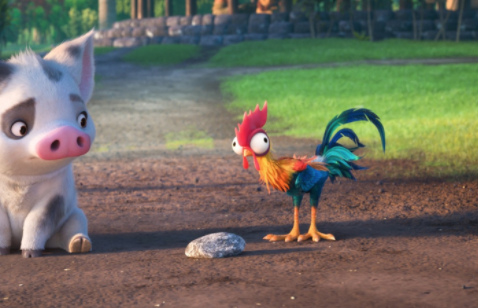
Let’s start with the name, Heihei (pronounced Hey Hey). If you don’t know, one of “Moana’s” larger definitions means ‘ocean, or wide expanse of water’ in Maori and Hawaiian. That makes sense and is useful in understanding the character. “Heihei” (sometimes Hei Hei) in the same language, means ‘disturbance’ or an ‘interruption from the norm.’ That’s a big clue to his personality but also his place in the story. Let’s get back to that.
In a larger sense, Heihei represents the Moana story. We learn that the people Moana will soon lead have lived for centuries on their island, never leaving its shores, fearful to cross the boundaries of the reef that surround it. They essentially live on a rock they peck away at day-by-day, having to shift depleting coconut groves and waning fishing spots to try and keep food on their tables.
Now, compare that with an early scene, where we see Heihei actually pecking at a single isolated rock (like an island), to which a villager comments how the chicken “seems to lack the basic intelligence required for pretty much . . . everything.” Heihei attempts to ingest the rock before being forced to toss it back up. And so we have a chicken trying to make food of a rock, not able to look beyond it and see there is plenty elsewhere. So committed to the rock, Heihei literally swallows it before realizing what it is. So what’s going on? Well, the rock represents the island and the chicken the people living on it, or more properly, their belief in isolation. It’s a sharp visual metaphor of the people’s plight and incongruous relationship with the sea itself. It’s a chicken dressed in high-level social commentary.
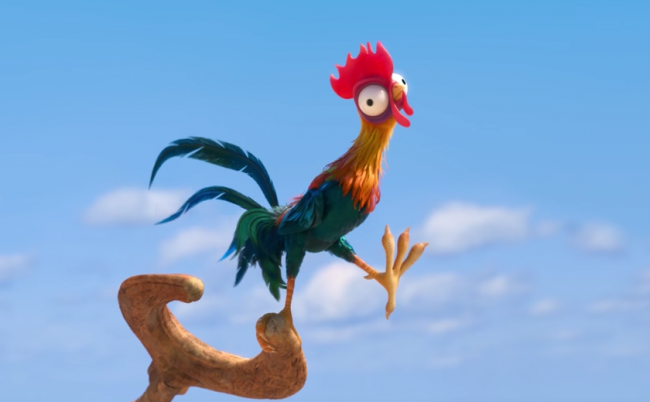
Moving on. Not long after, when Heihei stows aboard Moana’s boat, Moana discovers him in a small compartment and pulls him out (it’s wearing half a coconut on its head that conceals its entire face, a theme I’ll get to in a just a bit). When she removes the pot and the chicken looks around and sees that they have actually hurdled the reef and are out on the open ocean, it lets out a panicked, hilarious shriek, the camera pulling back to reveal how small and insignificant the boat appears on the vast roiling waters. Heihei, still representing the island people, gives witness to the fear that has kept them landlocked. The ocean has long represented a future of uncertainty, and here it becomes literal.

At one point though, Heihei comes to be on dry land, his face and head now covered by a cooking pot. This is important. Unable to see, it continues to walk repeatedly into the rocks, banging against them as if unable to recognize the futility of his actions. Are not the people back on Moana’s island also blinded by their own self-imposed limitations, banging their heads metaphorically against time and the island, hoping it can sustain them indefinitely? It’s a sharp visual that showcases the spirit of the people but also the fallacy of thinking they can maintain themselves as they are.

Notice too how Maui, the demigod (voiced by Dwayne Johnson) interacts with Heihei. We learn that Maui created the islands on the sea for the people to live upon and explore, guiding them to the lands they populate. Now, keeping in mind that Heihei represents the island people, we see at one point the bird pecking away at nothing, a small mound of seed just to one side, the bird seemingly oblivious to the meal. Maui, seeing this, gives the chicken a gentle nudge, essentially guiding Heihei to food, a motion that not only represents his earlier actions in guiding people to the islands (where food is aplenty) but foreshadows a near future as well.
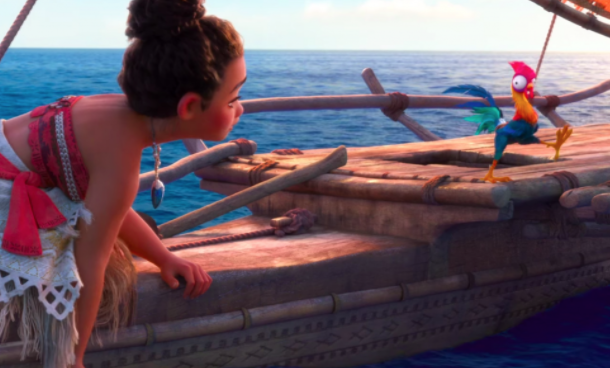
But let’s talk about the relationship that connects the chicken to Moana. In an early scene, while Moana is a toddler, she is lulled to the shores of the island and becomes so curious about the ocean, it is almost impossible for her not to keep wanting to go to it, to the point where her father physically has to drag her away, even when she is older. So too does Heihei become drawn to the water, stepping off the boat over and over, and at one point once ashore, turning and walking right back into the surf (the ocean then turns the bird around).

All of these chicken moments are presented with great humor of course and superficially portray the bird as ridiculously dumb, but there is a layer of intent about Heihei, a drive and determination that plays as lacking in intelligence, but is subtly comforting. At one point, it seems Moana will lose the green stone heart to the water and Heihei suddenly leaps from off screen and bites it out of the air, saving it from the watery abyss. Two things to note here: one, Heihei spends much of his time being shoved into a small compartment on the boat, over and over trying to escape it, mirroring Moana’s own life as she was forced to stay on her island, even as she tried over and over to get off it. In this moment, Heihei emerges from the box and saves the stone, thus allowing Moana to fulfill her destiny. Heihei represents Moana path here. Moana emerged from her own ‘compartment’ in life back on the island and in so doing, found her courage. Second, the biting of the stone circles back to the first time we met the chicken, biting and swallowing the rock from before. This time though, Heihei doesn’t swallow it, learning its lesson, that the value of it lies elsewhere. In a most telling moment, when it’s over, Maui sees Heihei, brought ashore by the water itself, and proclaims with a sense of knowing: “The chicken lives.” And so too do Moana and her people. Heihei literally lives up to its name, representing great challenges and a break from normality for Moana and the world she lives in.
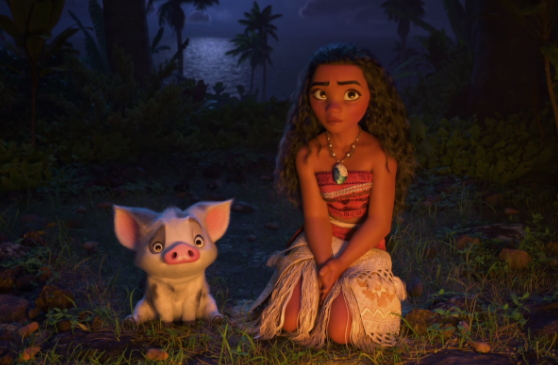
Perhaps the best part of Moana the film is that it knows the tropes it has created. It sets up a scene where in fact Moana the girl might have a perfunctorily adorable piglet named Pua as her companion in the story, and indeed, when the times comes when Heihei is revealed to be the stowaway, we are confident that it will be Pua. Our expectations shifted, we casually dismiss the chicken as comedy relief and miss the real point. Heihei is the true sidekick and one of far larger value than we think.
